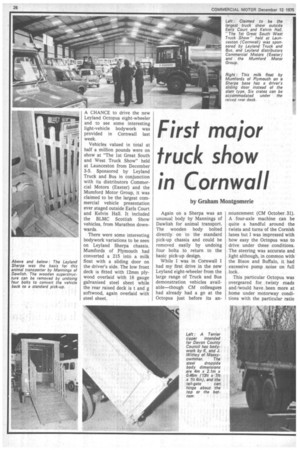First major truck show in Cornwall
Page 30

Page 31

If you've noticed an error in this article please click here to report it so we can fix it.
by Graham Montgomerie
A CHANCE to drive the new Leyland Octopus eight-wheeler and to see some interesting light-vehicle bodywork was provided in Cornwall last week.
Vehicles valued in total at half a million pounds were on show at "The 1st Great South and West Truck Show" held at Launceston from December 3-5. Sponsored by Leyland Truck and Bus in conjunction with its distributors Commercial Motors (Exeter) and the Mumford Motor Group, it was claimed to be the largest commercial vehicle presentation ever staged outside Earls Court and Kelvin Hall. It included the BLMC Scottish Show vehicles, from Marathon downwards.
There were some interesting bodywork variations to be seen on Leyland Sherpa chassis. Mumfords of Plymouth had converted a 215 into a milk float with a sliding door on the driver's side. The low front deck is fitted with 12mm plywood overlaid with 18 gauge galvanised steel sheet while the rear raised deck is t and g softwood, again overlaid with steel sheet. Again on a Sherpa was an unusual body by Mannings of Dawlish for animal transport. The wooden body bolted directly on to the standard pick-up chassis and could be removed easily by undoing four bolts to return to the basic pick-up design.
While I was in Cornwall I had my first drive in the new Leyland eight-wheeler from the large range of Truck and Bus demonstration vehicles available—though CM colleagues had already had a go at the Octopus just before its an nouncement (CM October 31). A four-axle machine can be quite a handful around the twists and turns of the Cornish lanes but I was impressed with how easy the Octopus was to drive under these conditions. The steering was accurate and light although, in common with the Bison and Buffalo, it had excessive pump noise on full lock.
This particular Octopus was overgeared for twisty roads and/would have been more at home under motorway conditions with the particular ratio fitted, although once on the road it would still start from rest fully laden in second gear in the Fuller box.
The crawler bottom gear was necessary only once and that was to get the truck out of the mud of the demonstration park and on to the road. Even allowing for the high axle ratio the Octopus made heavy weather of this, and a considerable portion of clutch lining was expended in the process—and in site-work terms the conditions were not really that bad.
The Ergomatic cab and control layout are the same as the Buffalo and Bison models, with entry and exit very easy —a point often forgotten on tippers. The rubbers on the brake and clutch pedals had very small ribs on them which caused me to miss the pedals initially as my wet shoes slipped off.
The Leyland men went to great pains to remind me that this model was a prototype only and that the production models should, in particular, be somewhat quieter in the cab.














































































